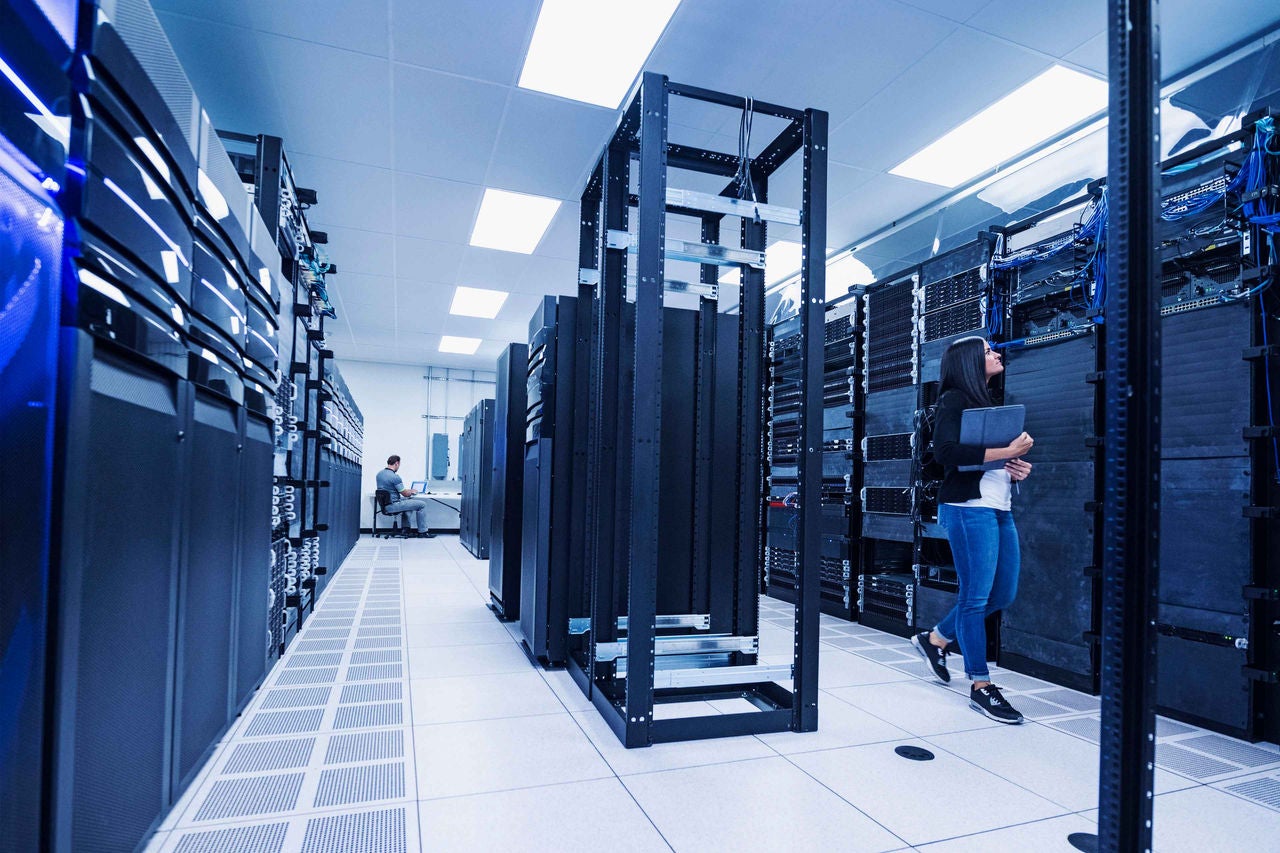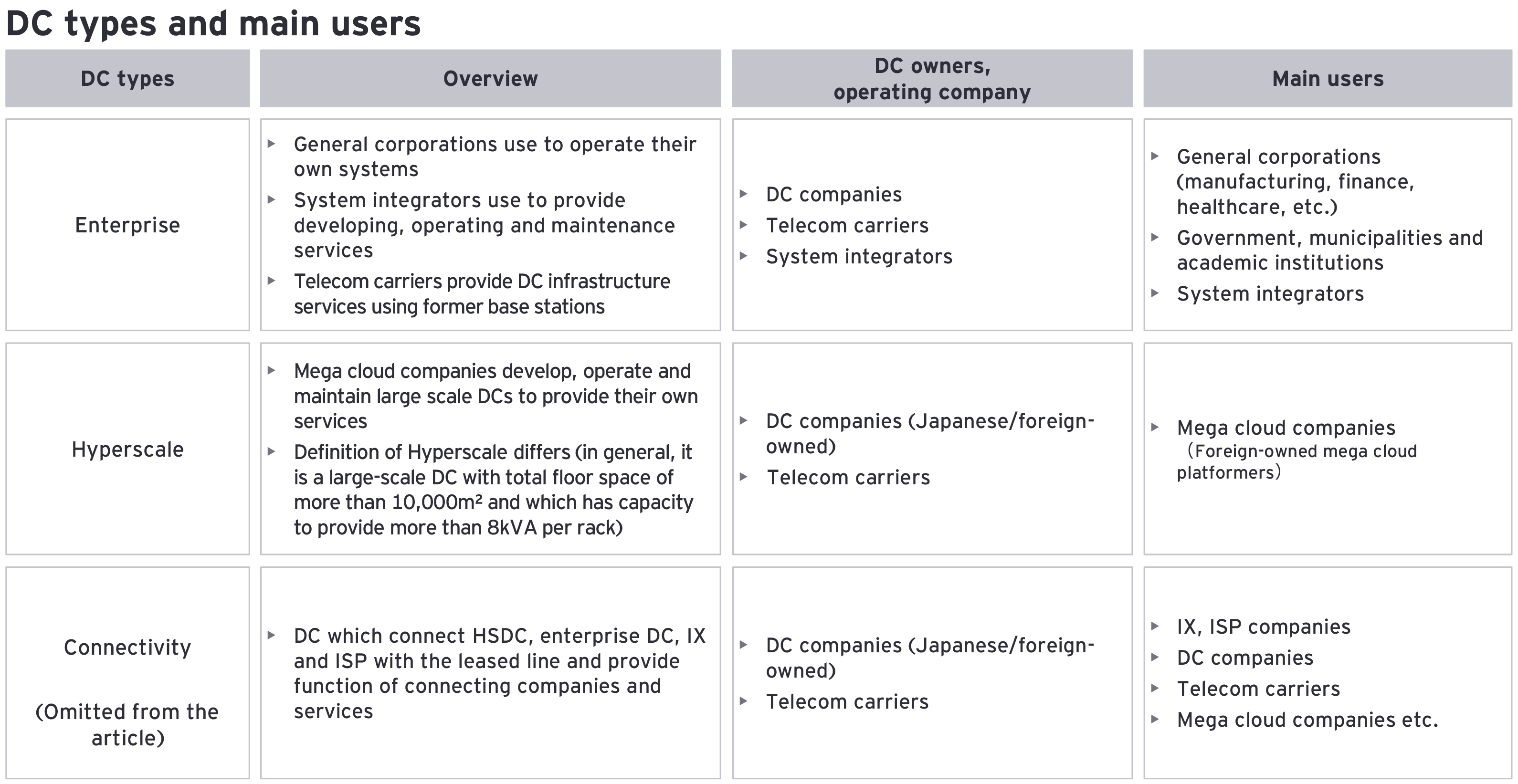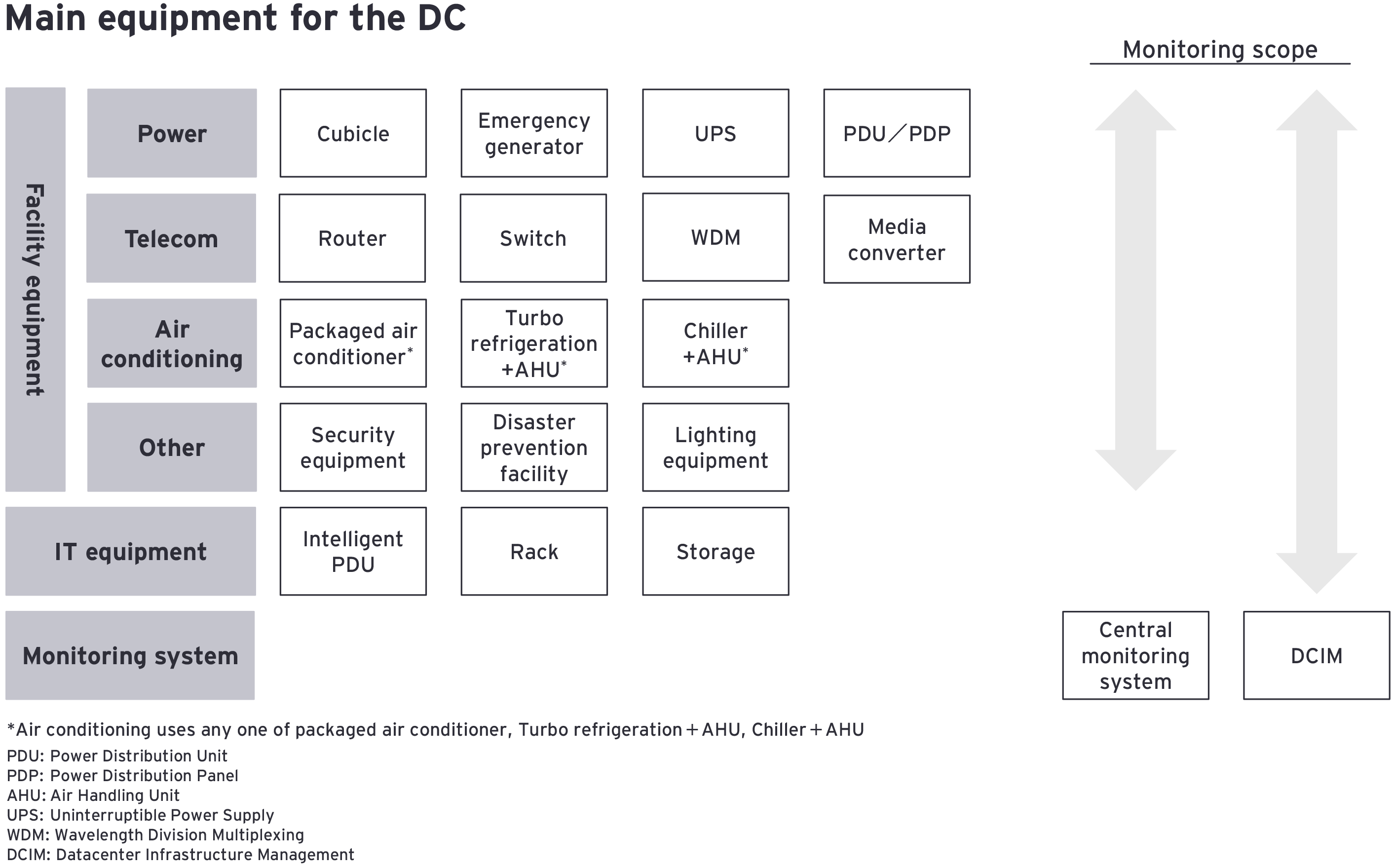EY refers to the global organization, and may refer to one or more, of the member firms of Ernst & Young Global Limited, each of which is a separate legal entity. Ernst & Young Global Limited, a UK company limited by guarantee, does not provide services to clients.

The data center (DC) market in Japan is experiencing high growth and gaining interest as a business opportunity. We take an in-depth look at five key points to consider for companies developing a DC business: leveraging capability, recruiting and re-skilling, establishing good relationships with industry insiders, flexible organizations and adapting to changes in the external environment.
In brief
- The DC market in Japan comprises two main segments: Enterprise DC (traditional DC) and Hyper scale DC (HSDC). While the enterprise DC market is projected to plateau, the HSDC market is expected to reach US$30 billion by 2026, up from US$23 billion in 2021, with a CAGR of 6.5%.
- There are many other stakeholders in the DC business beyond DC operators. These include but are not limited to architectural design, construction and consulting firms, facility manufacturers, electricity suppliers, telecommunication carrier, and financial investors.
- Trends in the external environment such as green measures, government promotion of local DCs, and changes to industrial structure and evolving lifestyles due to technological advances, all have a significant impact on the DC market in Japan.
Due to the expansion of cloud services, global cloud service providers which generate big data represented by mega cloud platformers are actively investing in HSDC in Japan. In contrast, there is stable demand for traditional enterprise DC for mainstream companies.
Did you know that various stakeholders are involved in a DC business, and there is a complex interaction between them in order to run their business?
Read our analysis of the DC market in Japan and how companies can take advantage of this business opportunity.
1. Japan DC market forecast
The DC market in Japan has a forecast value of $30 billion in 2026, up from $23 billion in 2021. With CAGR of 6.5%, there is also active investment in the market.
The expansion of public cloud services is the reason for this growth. Companies adopt public cloud services when they develop systems: they do not require massive investment in facilities, their operation is usually stable and they offer scalability and reliability. In addition, the demand for cloud services from end-users who are ordinary consumers has been increasing due to a change in lifestyles and the widespread introduction of remote working during the COVID-19 pandemic. As a result, there is accelerated investment by mega cloud platformers and DC companies which lease HSDC (HSDC companies). For these reasons, the HSDC market is currently leading the growth of the DC market.
However, the enterprise DC market developed by system integrators and telecommunications companies is also forecasting stable demand. The market is expected to plateau as there is a continuing need to maintain or update legacy systems: e.g. to manage a corporate business continuity plan (BCP), to migrate data to the private cloud for structuring back-up systems, to expand the hybrid cloud and the difficulties of data migration from the perspective of security and privacy for finance, healthcare and medical companies.
In today’s market environment, DC companies involved in enterprise DC are increasing their investment in a growing segment of the market: the hyper scale domain. Stakeholders, for example telecommunications and energy companies, are regarding the HSDC market as a business opportunity and expanding into the market.

2. Main DC users
The DC market is expected to grow but which users are present?
Users can be classified as mega cloud platformers including global tech companies, and general corporations including manufacturing, finance, healthcare companies and system integrators. Government, municipalities and academic institution are also included in the latter group.
As mega cloud platformers use DCs to provide their own services, quality assurance (ultra-low latency, fast and large capacity data processing etc.) is a prerequisite. There is increasing demand for large-scale DCs (HSDC) which can handle large scale data traffic.
In the case of general companies such as life sciences companies and financial and healthcare institutions, there is a demand for systems which are not suited to the cloud because of security concerns and the need to protect personal information. In addition, system integrators own or lease DCs as an infrastructure to provide managed services such as system development and operations.
There is also an emphasis on BCP and security measures for both mega cloud platformers and general companies.

3. Stakeholders in the DC business
Apart from mega cloud platformers and general companies, there are many other stakeholders in the DC business.
Design companies, general contractors/construction companies and consulting firms may all be involved in acquiring a site and constructing a DC. These stakeholders receive instructions and specifications from the DC operators and play a role in searching suitable sites for acquisition and construction. With regard to consulting, real estate businesses and other actors provide support or act as intermediaries when a mega cloud platformer invests in HSDC construction in Japan. They have a role both to support site acquisition and to coordinate other stakeholders based on usual Japanese business practice.
In terms of equipment supply, there are manufacturers for heating, ventilation, and air conditioning (HVAC), power supply, central monitoring systems and data center infrastructure management (DCIM) and IT equipment makers handling network server and telecommunication equipment.
For infrastructure there are electric power companies which provide stable high voltage power services for HSDC, telecom carriers and network broadcasting stations which provide connectivity between DCs, internet exchange points (IX) and internet service providers (ISP).
The DC operator for both HSDC and enterprise DC is the DC company, which coordinates stakeholders to maintain and operate the DC.
For each process from development to operations, the DC company may at any time act as a central point to manage the DC business. Furthermore, a HSDC development plan depends on demand from mega cloud platformers and, therefore, there are many cases where a DC is developed to meet the detailed specifications of mega cloud platformers. On occasions, mega cloud platformers may communicate directly with other stakeholders to outline their requirements.


In the case of a large scale DC, a general trading company (sogo shosha), a real estate company and a real estate PE fund may join the business as a financial sponsor. The DC company may call on a financial sponsor to participate in the business to share the investment risk, or on the contrary, a financial sponsor with an appropriate site may offer a business to a DC company. Recently, there also has been a case where a financial sponsor invests or acquires a DC company and then manages a DC business in addition to providing the site and funding.
4. Changes in the DC market environment in Japan
Many stakeholders exist in the DC business so how will the market evolve?
How to account for changes in the external environment will be a key factor for a company to succeed.
- Green measures
Energy consumption is increasing due to the upscaling of DC due to data traffic increases. Environmental issues such as carbon neutrality are global trends but in Japan, the renewable energy sufficiency rate remains low and attempts to achieve a carbon-free society are not yet halfway. For this reason, any attempt to control and optimize energy consumption in order to green the DC is limited.
However, green measures from mega cloud platformers, driven by an overseas focus on green management, can spread widely so solutions need to be considered from an early stage.
- Government promotion of local DCs
More recently, government has promoted decentralization of DCs and a subsidy system. Examples include decentralization of DCs and IX points and subsidies for energy and telecommunication management costs when laying submarine cables. These are aimed to establish DCs and landing stations for submarine cables in more rural locations. However, compensation for investment is not enough to encourage decentralization. There remain the issues of securing energy supply, ensuring the length and connectivity of communication networks achieves low latency, talent supply and more particularly user acquisition. Even if DCs are built in rural areas, the business will not grow if users do not exist. This is supported by the fact that many DCs exist in Tokyo, Nagoya and Osaka, where there is a higher population density. These issues have to be resolved in order to advance decentralization.
- Changes to industrial structure and evolving lifestyles due to technological advances
In addition to the expansion of cloud services, we should expect an increase in demand for processing huge amounts of data, in applications such as managing automatic construction robots or remote surgery using digital twins, processing data for autonomous driving, dealing with an increase in contents for extended reality (XR) and live commentary, etc. As a result, there will be a need for ultra-fast, large capacity and low-latency data processing. Currently, DC-related investment by DC companies and mega cloud platformers is focused on the Kanto and Kansai regions where telecoms traffic is concentrated, but there is the possibility of investment in regional areas, including expansion in surrounding areas or investment in edge computing. Particular attention should be paid to these trends.
5. Key points to consider when developing a DC business in Japan
What are the main considerations for companies looking to develop a DC business?
Read on for five key points to consider for a DC business in Japan.
- Leverage your existing capabilities
It is important to identify and develop a DC business which has high degree of affinity with your company’s current business and services. The existing business will be the starting point for expanding into new areas and targeting new users.
If the new business differs significantly from your current business and has to be developed from zero, you should consider being a financial backer who is able to provide a site for the facility. Securing an appropriate site is key to the success of a DC business. Many companies are struggling to make good use of idle land such as former factories and warehouses. Repurposing sites developed for residential or commercial facilities as a DC site is now emerging as a corporate real estate strategy. Participating in a DC business as a financial backer providing a site and accumulating the associated business know-how will enable expansion to other business areas. Knowledge can also be gained by investing in projects launched by trading companies (sogo shosha) or DC funds. The full or partial acquisition of a company with experience of operating a DC can be an alternative approach to enter the sector.
- Recruit English-speaking talent
Mega cloud platformers, which are the main users of HSDC, are often foreign-owned. As they expand their business in Japan, there will be increased demand for talent which is well versed in acquiring real estate and familiar with Japanese business customs in addition to proven fluency in English. From an operating perspective, talent with energy or telecoms expertise who are also able to respond in English to inquiries from a foreign parent company will be in demand. However, as there is a skills shortage in this area, investing in your own human resources, including reskilling, may increase opportunities for new business.
- Establish good relationships with industry insiders
Speed in identifying trends for DC users and DC companies, and specifying how to approach to the market are key to success. The DC business is limited to a small number of players with correspondingly high barriers to entry. Providing services to these players can be an important gateway to developing relationships with an inner circle of stakeholders.
There are also many instances where the Japanese subsidiaries of mega cloud platformers are not authorized to invest locally: this creates opportunities to follow the latest trends of mega cloud platformers and to develop global connections. Companies considering developing a DC business should participate in global exhibitions in order to meet and exchange information with decisionmakers from mega cloud platformers and related stakeholders.
- Build a flexible organization
Capturing the rapid spread of cloud services and content services requires quick decision making for DC development. Mega cloud platformers and HSDC companies tend to favor flexible and prompt operations and fast investment decisions. Companies should review whether their organization is able to respond appropriately.
- Adapt to changes in the external environment
Due to the evolution of technology, various use cases will arise, for example, digital twins, autonomous driving, and XR. As a result, demand for a DC with ultra-low latency or ultra-fast data processing will increase. Also, there is currently limited demand for green measures and decentralization but it is important to follow changes in the external environment, such as social trends and government policy, and to decide if a business development and investment plan is a priority.
As the DC market expands, there are many business opportunities for Japanese companies. Whether it is enterprise DC, mainly used by general companies, or HSDC led by mega cloud overseas platformers, we see opportunities for aggressive development and investment with potential for success.
6. Conclusion
These insights for developing a DC business in Japan are based on analysis of case studies and knowledge accumulated through EY’s consulting on this type of engagement. With stable demand for enterprise DC targeting general users and expansion of HSDC domain for mega cloud platformers due to the evolution of cloud services, DCs offer an attractive business environment. Companies can achieve success in the DC business in Japan if they follow the key points identified in this article.
Authors
EY Strategy and Consulting Co., Ltd.
Technology/Media Entertainment/Telecom Sector
Mikio Mizushima (Senior Manager)
Shun Ikegami (Manager)
Mana Higuchi (Senior Consultant)
EY Parthenon Strategy
Toru Okazaki (Director)
*Authors are listed under departments and titles as of the publication date.
Summary
The DC market in Japan is an attractive business area for both Enterprise DC and HSDC. However, there are important considerations prior to market entry or business expansion.
Based on EY's analysis of stakeholder trends and anticipated external environmental changes, we have identified five key points to consider in developing DCs.


